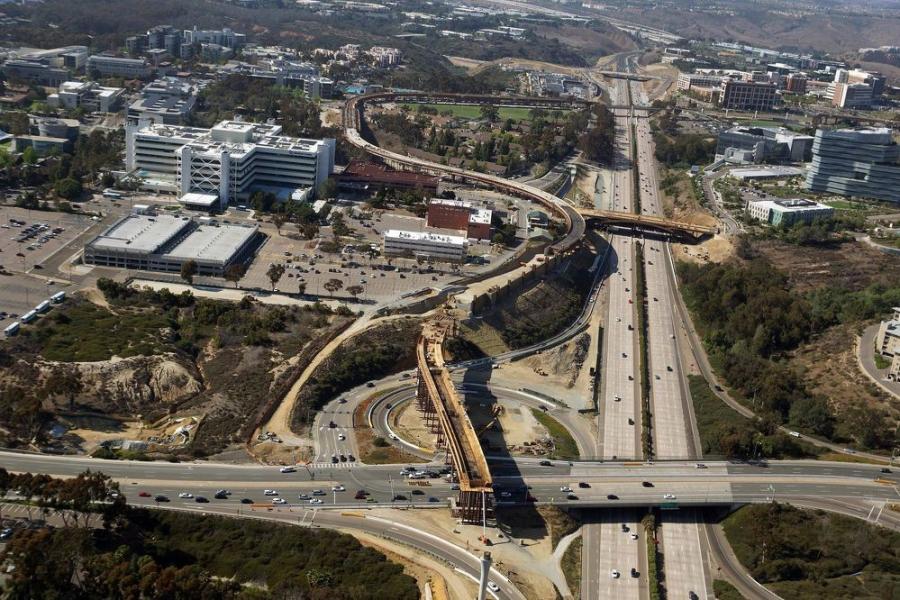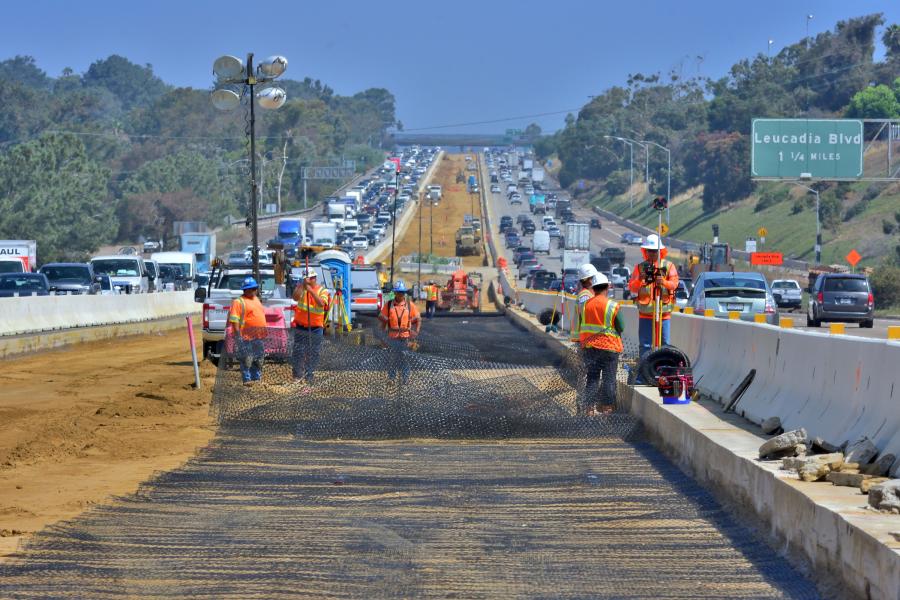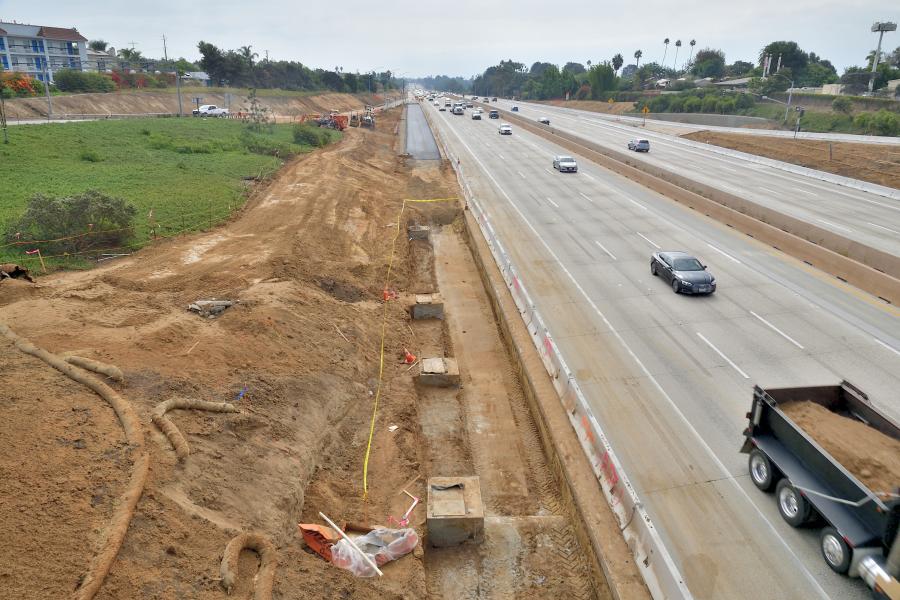The Caltrans and SANDAG North Coast Corridor Program is a 40-year, $6 billion balanced set of highway, rail, environmental and bike and pedestrian mobility and coastal access projects for north coastal San Diego County.
Earthwork and road construction operations are pressing forward on an 8-mi. stretch of Interstate 5 (I-5) to enable the busy highway corridor in San Diego County to accommodate two new carpool/high occupancy vehicle (HOV) Lanes — one in each direction — between Lomas Santa Fe Drive in Solana Beach and Palomar Airport Road in Carlsbad.
The Flatiron, Skanska and Stacy and Witbeck joint-venture (FSSW) is responsible for the construction, as well as other nearby multi-modal and active transportation projects.
The project is part of a phase of construction (referred to as "Build NCC") of the Caltrans and SANDAG North Coast Corridor Program, a 40-year, $6 billion balanced set of highway, rail, environmental and bike and pedestrian mobility and coastal access projects for north coastal San Diego County.
The Build NCC program began in 2017 and is anticipated to be complete in 2022. The $869 million project is funded through a combination of federal, state and local sources, including the TransNet program, a voter approved half-cent countywide sales tax that helps fund regional transportation projects. The highway portion of Build NCC is estimated to cost $663 million.
Construction of the I-5 carpool/HOV lanes broke ground in November 2018 and is anticipated to be completed in late 2021. This section of I-5, built in the 1960s and located in the coastal cities of Encinitas and Carlsbad, carries on average more than 750,000 cars and freight trucks daily. The project will extend existing I-5 carpool/HOV lanes located in the cities of San Diego, Del Mar and Solana Beach further north to provide commuters with an additional travel option to help meet regional traffic demands over the coming decades.
In addition to the new carpool/HOV lanes, Caltrans and SANDAG Build NCC crews are working on other I-5 highway improvements, which include reconstructing the I-5 San Elijo Lagoon highway bridge, building new bicycle and pedestrian facilities parallel to I-5 and at various interchanges, and constructing multiple sound walls in the cities of Encinitas and Carlsbad.
Construction Progress
"In mid-summer, our highway construction team completed the transition of construction operations from the inside median to the outside freeway shoulders," said David Sharpnack, FSSW's project manager. "Now that we are in the second phase of the project, crews are installing new drainage and electrical infrastructure, performing earth work operations to shape new slopes and embankments, and completing roadway paving along the outside freeway shoulders to accommodate the added carpool/HOV lane."
To date, the JV has completed I-5 median reconstruction along the entire project limits. Much of 2021 will have crews focus on installing underground utility infrastructure, reconstructing the outside freeway shoulders, slopes and embankments, performing on- and off-ramp realignment work, and paving new roadway and outside shoulders.
The approach to the construction project began with placing k-rail along the inside shoulder so that crews could reconstruct the center median in the first stage of construction before shifting k-rail and switching to the outside freeway shoulders in the second stage of construction.
Project Challenges
"One project challenge included the limited space to operate and maneuver equipment and vehicles within the I-5 median as barrier construction was under way," said Sharpnack, "and crews were able to overcome this by establishing a one-way driving direction from south to north at low speeds to avoid construction activities. By working in the median first, space was created to move traffic toward the reconstructed median during the second stage of outside shoulder work."
The major subcontractors for the project include Calmex for asphalt paving; CGO Construction for clearing and grubbing; Cooper Engineering for barrier rail construction; Griffith for landscaping; and Select Electric for electrical utility work.
Earth work, excavation and demolition should generate 35,000 cu. yds. of asphalt and 237,000 cu. yds. of earth and rock. During construction, FSSW uses recycled materials by demolishing existing asphalt or concrete roadway with an on-site crusher for reuse as base within the project.
Equipment being used includes: 35 ton Lorain MCH350Ds crane; Cat 308s excavators; Cat D6 dozers; John Deere 672G motor graders; Cat 950 loaders; Bomag 3-to-5-ton rollers; and GOMACO GP-2400 pavers.
"One main wear and tear issue is vehicle tire damage resulting from activities throughout the project limits," said Sharpnack, "and on- site mechanics perform regular maintenance as needed during non-work hours."
The JV purchases and rents equipment from Ken Grody Ford in Carlsbad; Otay Mesa Sales Inc. in San Diego; United Rentals in San Diego; and Savala Equipment Rentals in Irvine.
"In the face of this global COVID-19 pandemic, our construction crews are deemed essential and have continued to make progress every single week while adhering to a host of new public health and safety protocols," said Yong Pak, Caltrans resident engineer. "We are thankful and appreciative to every single team member, from our designers and engineers to our contractor and our skilled craftspeople, for their commitment to this project and their duties during these unprecedented times."
The road work and infrastructure projects were designed by Caltrans, with input from FSSW through a process called Construction Manager General Contractor (CMGC).
"Prior to construction, Caltrans and FSSW participated in early discussions to develop a comprehensive project design and approach based on the contractor's input and feedback on overall constructability and timelines," said Pak. "The CMGC model is highly effective when facing unforeseen field issues during construction because the established partnership between Caltrans and FSSW helps strengthen compromise with any necessary project change orders."
To ensure the safety of the traveling public and highway construction crews, Caltrans and SANDAG implemented a temporarily reduced speed limit in March 2019, bringing the speed limit down from 65 to 55 mph through the 8-mi. Build NCC project limits on I-5 through project completion in 2022.
As part of the project, night work is necessary throughout the 8-mi. stretch of I-5 carpool/HOV lane construction because it enhances crew member safety. Overnight shifts enable crews to implement traffic control measures, such as temporary freeway lane or ramp closures, during periods of time where there are decreased traffic volumes on the freeway.
These lane closures provide protection for crew members by allowing them to safely enter and exit the I-5 median or outside freeway shoulders with construction vehicles, equipment and materials to perform various construction activities. Crews rotate around the 8-mi. corridor frequently, depending on current construction activities and daily nighttime lane closures. CEG
Irwin Rapoport
A journalist who started his career at a weekly community newspaper, Irwin Rapoport has written about construction and architecture for more than 15 years, as well as a variety of other subjects, such as recycling, environmental issues, business supply chains, property development, pulp and paper, agriculture, solar power and energy, and education. Getting the story right and illustrating the hard work and professionalism that goes into completing road, bridge, and building projects is important to him. A key element of his construction articles is to provide readers with an opportunity to see how general contractors and departments of transportation complete their projects and address challenges so that lessons learned can be shared with a wider audience.
Rapoport has a BA in History and a Minor in Political Science from Concordia University. His hobbies include hiking, birding, cycling, reading, going to concerts and plays, hanging out with friends and family, and architecture. He is keen to one day write an MA thesis on military and economic planning by the Great Powers prior to the start of the First World War.
Read more from Irwin Rapoport here.
Today's top stories


















